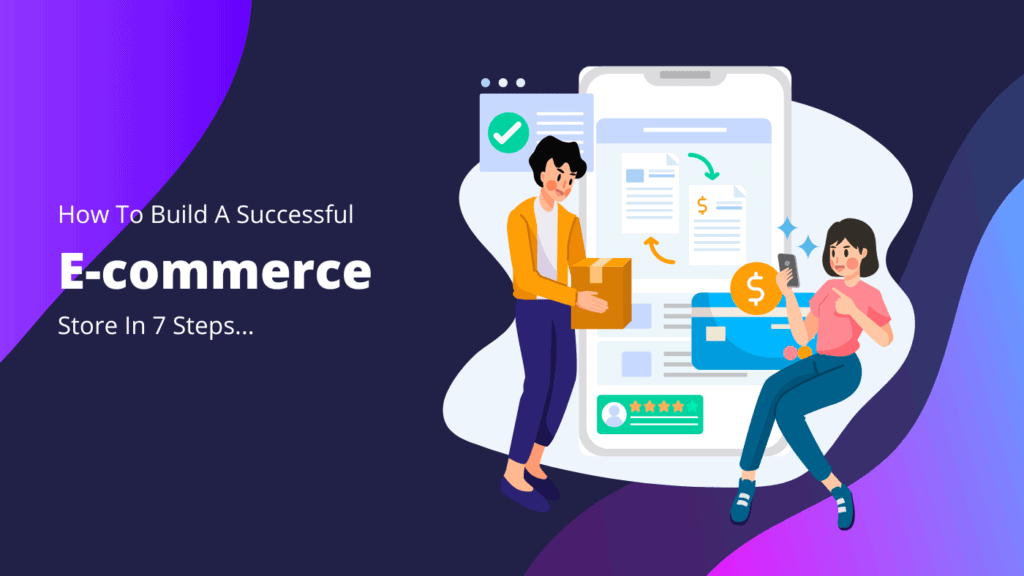Introduction: what is E-Commerce and why should you consider it?
E-commerce is the process of buying and selling goods and services online. It has become a popular way for businesses to reach new customers, reduce overhead costs, and increase their profits. With an e-commerce platform, you can create an online store that allows customers to purchase products or services directly from your website. By leveraging the power of digital technology, you can make it easier for customers to find what they need quickly and securely. With an e-commerce business, you have the potential to increase sales, improve customer service, and expand your reach beyond traditional brick-and-mortar stores.
Why E-commerce is the future of business & how to get started
E-commerce is transforming the way we do business, and it is quickly becoming the future of the global economy. With an e-commerce business model, businesses can operate online with a lower overhead cost and reach customers all over the world. Starting an e-commerce business is easier than ever today, thanks to advanced e-commerce website builders that make it simple to get started.
Whether you are a small business or a large corporation, there are many advantages to running an online store. By leveraging the power of e-commerce platforms, businesses can increase their sales and market their products to a wider customer base without needing a physical store. With these insights in mind, let’s take a closer look at why e-commerce is the future of business and how you can get started today.
It starts with choosing a good platform for your e-commerce business, creating a winning digital storefront and maximizing conversions, having good marketing strategies for your e-commerce business, and driving traffic to your store.
How to create a winning digital storefront & maximize conversions
Creating a winning digital storefront requires careful planning and optimization. It’s not enough to just have an online shop with great products; you need to ensure that your store is designed in a way that will maximize conversions.
In this article, we’ll discuss the best practices for designing a digital storefront, from website optimization to product placement. We’ll also explore some of the latest trends in online shop design and discuss how you can use them to boost your conversion rates. With the right strategies, you can make sure that your digital storefront stands out from the competition and drives more sales for your business.
How to choose the right platform for your E-Commerce business
When it comes to starting an e-commerce business, the right platform is key. With so many options available, it can be difficult to know which platform is best for your business. To ensure that you make the right choice, there are a few factors you should consider when selecting the right platform for your e-commerce business. These include cost, scalability, features and integrations, customer support, and security.
Taking the time to research these factors will help you make an informed decision that will benefit your business in the long run. Here are some platforms that can help you.
5 best platforms for your E-commerce business
Shopify
Shopify is a cloud-based platform that provides everything you need to create and run your online store. It offers a range of features, including customizable themes, mobile optimization, and built-in marketing tools.
WooCommerce
WooCommerce is a popular e-commerce plugin for WordPress, one of the most popular content management systems. It offers a range of features, including customizable themes, mobile optimization, and a range of plugins to extend functionality.
BigCommerce
BigCommerce is a cloud-based platform that offers a range of features, including customizable themes, mobile optimization, and built-in marketing tools. It also offers advanced features such as customer segmentation and multi-channel selling.
Magento
Magento is an open-source platform that offers a range of features, including customizable themes, mobile optimization, and advanced product management. It’s known for its scalability and flexibility, making it a popular choice for larger e-commerce businesses.
Squarespace
Squarespace is a website builder that offers e-commerce functionality as part of its platform. It offers a range of customizable templates, mobile optimization, and built-in marketing tools.
Marketing strategies for your E-Commerce business & driving traffic to your store
Marketing your e-commerce store is key to success. With the right marketing strategies, you can reach more potential customers and drive traffic to your store. Automation software for eCommerce stores can help you streamline and automate your marketing tasks, allowing you to focus on other areas of your business. Additionally, email marketing strategies are also essential for driving traffic to your store.
With effective email campaigns, you can engage with customers and build relationships that will lead to sales. By implementing the right marketing strategies for your e-commerce business, you can increase traffic and grow your business.
Marketing is an essential component of any e-commerce business. With so many competitors in the market, it’s crucial to have a solid marketing strategy that will help you stand out from the crowd and drive traffic to your store.
7 tips on marketing strategies for your e-commerce business and driving traffic to your store
Use a marketing automation software
A marketing automation software can be a game-changer for e-commerce businesses. This software can help you streamline your marketing efforts by automating tasks such as email campaigns, social media posts, and targeted advertising. This can save you time and resources while also increasing the effectiveness of your marketing efforts.
Use email marketing
Optimize for search engines
Search engine optimization (SEO) is critical for driving traffic to your e-commerce store. Optimize your website by using keywords and meta descriptions that are relevant to your products and industry. Ensure that your website is mobile-friendly and has fast load times, as these are factors that can impact your search engine rankings.
Utilize social media
Social media is an excellent tool for engaging with your customers and promoting your e-commerce store. Develop a social media strategy that includes a mix of organic and paid content, and use social media advertising to target specific audiences.
Implement customer loyalty programs
Customer loyalty programs can help you retain existing customers and attract new ones. Offer incentives such as exclusive promotions and discounts, free shipping, and early access to new products to encourage customer loyalty.
Use influencer marketing
Influencer marketing is an effective way to reach new audiences and promote your products. Identify influencers who have a following that aligns with your target audience, and collaborate with them to promote your products.
Offer exceptional customer service
Exceptional customer service can be a powerful marketing tool. Respond quickly to customer inquiries and complaints, and offer a hassle-free return policy. Ensure that your website is easy to navigate and that the checkout process is simple and straightforward.
In conclusion, these are 7 tips on marketing strategies for your e-commerce business and driving traffic to your store. By utilizing marketing automation software, email marketing, SEO, social media, customer loyalty programs, influencer marketing, and exceptional customer service, you can increase your visibility and attract more customers to your store. Remember to analyze your marketing efforts regularly to identify areas for improvement and refine your strategy accordingly.
Key aspects to focus on when growing your E-Commerce business

E-commerce business owners face a unique set of challenges when it comes to growing their businesses. With the ever-changing landscape of digital marketing and the sheer amount of competition, it can be hard to stand out and gain traction. To help you grow your e-commerce business, here are five essential strategies you should consider implementing. These include digital marketing strategies such as search engine optimization (SEO) and email marketing, as well as other tactics like customer loyalty programs and social media outreach. By utilizing these strategies in tandem, you can maximize your reach and increase sales for your e-commerce business.
Here are 5 focus points for growing your e-commerce business
Focus on customer experience
The key to success in e-commerce is to provide your customers with a seamless and enjoyable shopping experience. Make sure your website is user-friendly and easy to navigate. Offer multiple payment options, fast and affordable shipping, and hassle-free returns. Ensure that customer service is responsive and helpful.
Invest in digital marketing
In order to attract new customers and retain existing ones, you need to invest in digital marketing. This includes search engine optimization (SEO), pay-per-click (PPC) advertising, email marketing, and social media marketing. Focus on creating engaging content that resonates with your target audience.
Use data to drive decisions
In e-commerce, data is king. Use analytics tools to track key metrics such as website traffic, conversion rates, and customer behavior. Use this data to make informed decisions about product offerings, pricing, and marketing campaigns.
Expand your product offerings
If you want to grow your e-commerce business, you need to continually expand your product offerings. Consider offering related products, complementary items, and new product lines. This will not only attract new customers but also increase sales from existing customers.
Build relationships with your customers
Finally, it’s important to build strong relationships with your customers. Offer loyalty programs, discounts, and personalized recommendations. Use social media to engage with customers and respond to their feedback. By building a loyal customer base, you’ll create a sustainable and profitable e-commerce business.
Top Tips on Designing an Engaging User Experience For Your Online Store
Designing a great user experience for your online store is essential for making sure that customers have an enjoyable shopping experience. It can make or break the success of your business. In this article, we will be discussing some top tips on how to design an engaging user experience for your online store. We will cover topics such as creating website designs that are optimized for mobile devices, using visuals and animations to create an immersive experience, and employing user-friendly navigation techniques. By following these tips, you can ensure that customers have a smooth journey when visiting your website and increase the chances of them making a purchase.
An engaging user experience is one that keeps your customers on your site longer, encourages them to explore your products, and ultimately leads to a higher conversion rate. Here are 10 tips on designing an engaging user experience for your online store:
10 Tips on Designing an Engaging User Experience For Your Online Store

Optimize for speed
Optimizing your website for speed is essential for providing a positive user experience. Slow-loading websites can lead to frustration and high bounce rates. Use website optimization tools to ensure your website loads quickly, and avoid using large image files that take a long time to load.
Simplify navigation
Navigation is key to providing an engaging user experience. Use intuitive navigation techniques that make it easy for customers to find what they are looking for. Avoid complex menus and keep the number of clicks required to make a purchase to a minimum.
Use visuals effectively
Images and videos are powerful tools for creating an engaging user experience. Use high-quality visuals to showcase your products and create an immersive experience for your customers. Ensure that the visuals are optimized for speed and load quickly.
Implement clear calls-to-action
Calls-to-action (CTAs) are a critical component of an engaging user experience. Use clear and concise CTAs that encourage customers to take action, such as “Add to Cart” or “Buy Now.” Use contrasting colors to make CTAs stand out, and avoid using too many CTAs on a single page.
Make it mobile-friendly
More and more people are using their mobile devices to shop online, so it’s important to ensure that your website is optimized for mobile devices. This means using responsive design and optimizing your website for smaller screens. Make sure that your website is easy to navigate on a mobile device, and that all of the features work properly.
Provide easy search functionality
Providing easy search functionality is another critical component of an engaging user experience. Implement a search bar that makes it easy for customers to find what they are looking for. Use autocomplete and suggested search terms to make the search process even easier.
Use social proof
Social proof is a powerful tool for building trust and encouraging customers to make a purchase. Use customer reviews and ratings to showcase the quality of your products and build trust with your customers.
Offer personalized recommendations
Personalized recommendations based on customer behavior are an effective way to showcase relevant products and increase the chances of a purchase. Use machine learning algorithms to analyze customer behavior and make personalized recommendations based on their browsing and purchasing history.
Provide easy checkout
Creating a user-friendly checkout process is essential for an enjoyable shopping experience. Make sure the checkout page is straightforward and doesn’t require excessive input. Providing multiple payment options should also be taken into consideration to make sure customers can easily purchase their desired item.
Test and refine
Finally, it’s important to continually test and refine your website design and user experience. Analyze user behavior and feedback to identify areas for improvement and make changes accordingly. Use A/B testing to test different variations of your website design and see which performs better.
How to Use Social Media & Influencers To Promote Your E-Commerce Store
Social media is a powerful tool for businesses of all sizes, especially e-commerce stores. With the right strategies, you can use social media to reach new customers, build relationships with existing customers, and promote your store to the world. You can also leverage influencers to help spread the word about your products and services. In this section, we will discuss how to use social media and influencers to promote your e-commerce store and increase sales.
7 tips on how to use social media and influencers to promote your e-commerce store

Define your goals
Start by defining your social media marketing goals, such as increasing sales, brand awareness, or engagement. Having a clear understanding of what you want to achieve will help you create a more effective strategy.
Identify the right social media channels
Different social media channels have different user demographics and content formats. Choose the social media channels that are most relevant to your target audience and the products you’re selling.
Build a strong brand presence
Create a consistent brand identity across all your social media channels. Use high-quality visuals and engaging captions to showcase your products and create a strong brand presence.
Collaborate with influencers
Work with influencers who align with your brand values and have an engaged following. Build a relationship with them and create engaging content that showcases your products.
Use influencer-generated content
Repurpose influencer-generated content across your social media channels to showcase your products and increase brand awareness. This content is often highly engaging and can help you reach a wider audience.
Leverage social media advertising
Use targeted social media advertising to reach users who match your target demographic. Use visually appealing ads that showcase your products and encourage users to click through to your e-commerce store.
Engage with your followers
Engage with your followers on social media by responding to comments, running social media contests, and offering promotions. This can help build a loyal customer base and increase brand awareness.
Conclusion
In conclusion, e-commerce businesses have revolutionized the way we shop and conduct business. With the help of an e-commerce platform, businesses can quickly build an online store and start selling their products to customers all over the world. An e-commerce website allows businesses to reach a wider audience and increase their profits by reducing costs associated with traditional retail stores. With the right strategies in place, e-commerce businesses can continue to grow and succeed in this ever-changing digital landscape.





